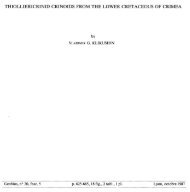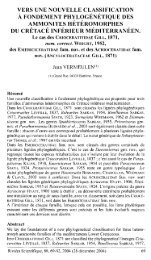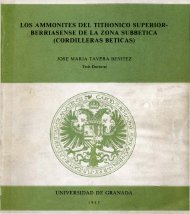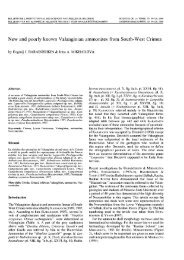peter franklin rawson, dennis curry, frank charles dilley, john michael ...
peter franklin rawson, dennis curry, frank charles dilley, john michael ...
peter franklin rawson, dennis curry, frank charles dilley, john michael ...
Create successful ePaper yourself
Turn your PDF publications into a flip-book with our unique Google optimized e-Paper software.
Cenomanian. Full details and comprehensive faunal lists of the Haldon Sands includingthe coral bed are given by Hamblin & Wood in Selwood et al., in press.The western outcrops: Wiltshire to Buckinghamshire (Column 11)From the Ryazanian to the early Albian this depositional area formed a westerlymargin to the Wessex basin, and pre-Gault Cretaceous occurs only in widelyseparated patches, being mostly the sedimentary record of three transgressiveepisodes that took place in the early Ryazanian, late Aptian and early Albian.The Cinder Bed horizon, marking the base of the non-marine Ryazanian, istraceable in the Vale of Wardour, south Wiltshire. It is not seen for 25 km underSalisbury Plain, but reappears in the Vale of Pewsey and continues (in near-marineWhitchurch Sand facies) some 120 km north-eastward to Stewkley, Buckinghamshire,in places overstepping the Lulworth Beds of the Purbeck to rest on PortlandBeds (Casey & Bristow 1964). It is only a metre or two in thickness.The so-called ‘Wealden Beds’ of Shotover, Wheatley and Milton, Oxfordshire(Shotover Ironsands), 20 m thick, have yielded no fossils of correlative value; theyhave beep equated with the Hastings Beds (Taylor 1959) or the Weald Clay (Ballance1964). South of Aylesbury, Buckinghamshire, there are a few other patches offerruginous sands of dubious relationships, some (e.g. at Stone) reputedly havingmolluscs and plants of Wealden type (Morris 1867).Evidence of the late Aptian (nutfieldiensis Zone) trangression is found along theforward edge of the Gault in Berkshire and Wiltshire, where up to 50 m of LowerGreensand deposits of highly individual character are entrenched into the Jurassic{see Casey 1961a). These include the Faringdon Sponge Gravels and the SeendIronsand. Thin glauconitic sands of early Albian {mammillatum Zone) age are morewidespread at the base of the Gault and overlap onto the Kimmeridge Clay. Certainother unfossiliferous sands running parallel with the Gault, such as the Red Sands ofUffington, in the Vale of the White Horse, Berkshire, and the Bedchester Sands nearShaftesbury (White 1923) may be early Albian (Casey 1961a, pp. 564-5).In this region the Gault is estimated to reach 80 m in thickness. The lower part ofthe Middle Albian (dentatus Zone) is well represented (e.g. at Thame, Buckinghamshire,and Culham, Oxfordshire), but only vestiges of the high Middle Albian havesurvived the late Albian transgression (Spath 1943). Upper Albian Gault Clay faciesare well known in the vicinity of Aylesbury and the succeeding Upper Greensandfacies is represented by the Malmstone (with the Potteme Rock in Wiltshire), of lateAlbian age, which runs through Wiltshire and Oxfordshire into Buckinghamshire.The English Channel (Column 12) and Western ApproachesCretaceous rocks underlie some two-thirds of the floor of this region and areexposed over nearly one-third of its surface (see maps in Boillot & Musellec 1975and Smith & Curry 1975, and Fig. 5 here). The facies in which they occur are similarto those known on nearby land. Lower Cretaceous beds are believed to be presentover almost the whole area north-east of a line from Portland to Le Havre. In theregion immediately south-west of this line they are absent (Dingwall 1971, p. 10).
















